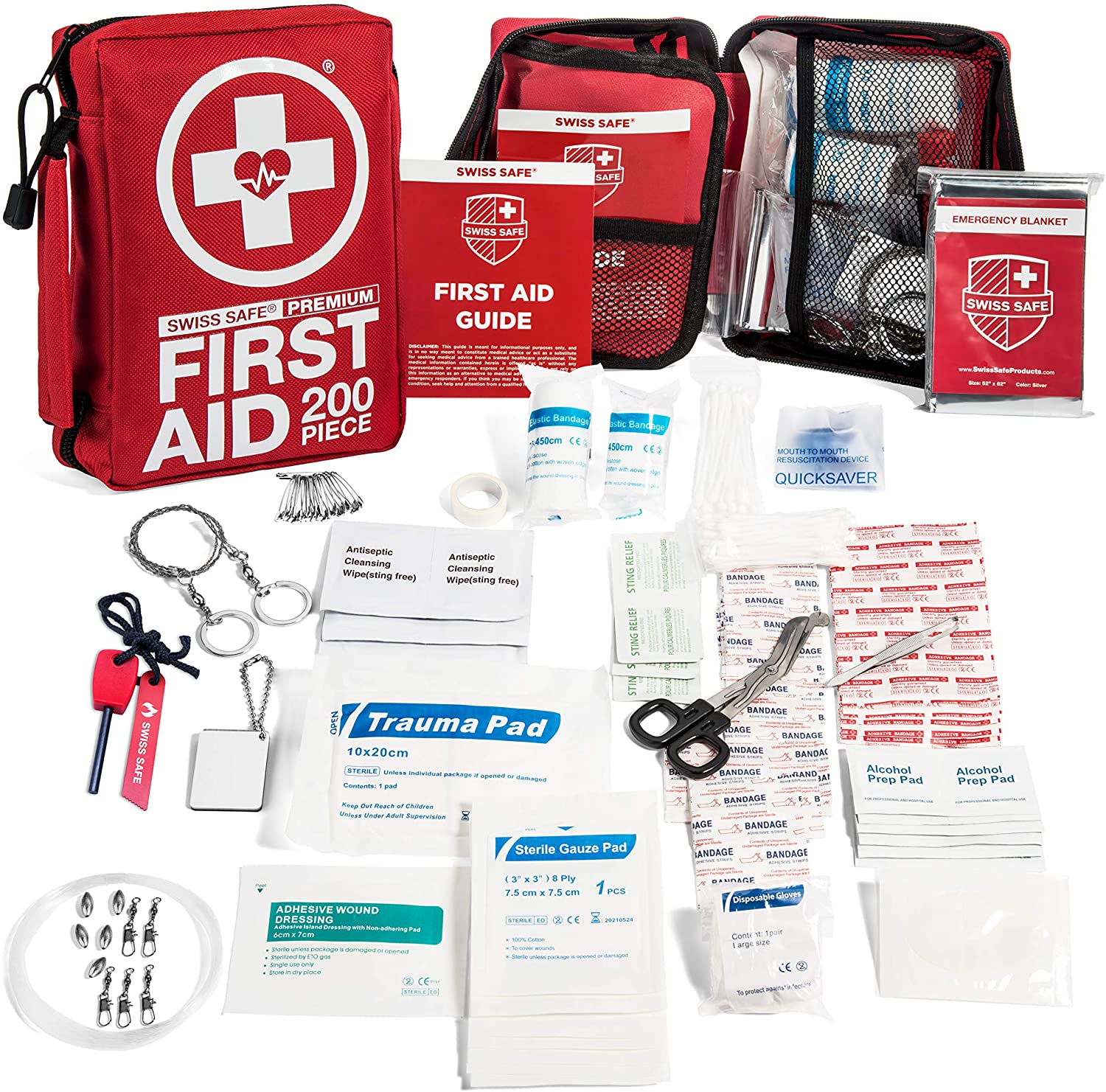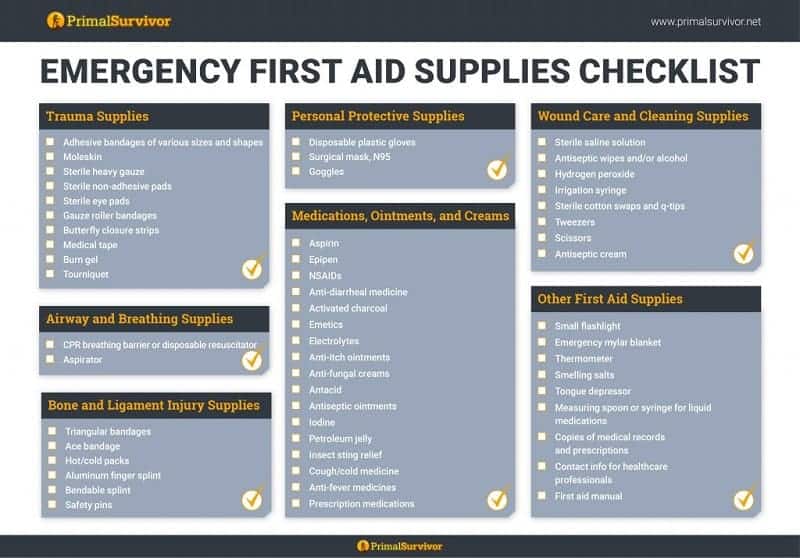
Survival First Aid Kit Checklist You Can’t Live Without
Author: Diane Vuković
[*]It is appalling how few people in the United States (and beyond) have a fully stocked first aid kit or know how to use the items in it!
According to the CDC, 44% of Americans don’t have a first aid kit.
The checklist is divided up by how the items are used. You may need to adjust the content lists of each category to fit your needs. However, ensure you have all core items from each category to prepare for all types of injuries. More detail on the items is provided after the checklist.
FREE FIRST AID CHECKLIST

[*]Get organized fast with our completely free checklist.
Download Checklist
Types of First Aid Supplies
Before giving you the checklist of first aid supplies, I want to make sure you understand the types of first aid supplies you need. This will help you when stocking your first aid kit. It will also help you organize the first aid supplies, making them easy to access based on emergency type.The main types of first aid supplies you will need are:
- Trauma first aid supplies
- Wound care and cleaning first aid supplies
- Bone and ligament injury first aid supplies
- Airway and breathing first aid supplies
- Personal protection first aid supplies
- Medications
Trauma First Aid Supplies
You use these supplies to treat wounds, such as cuts, scrapes, and burns. Items for cleaning wounds are listed in the next section. (With Amazon links.)- Adhesive bandages of various sizes and shapes (for minor wounds; these are applied directly to the injury)
- Moleskin (for blisters)
- Sterile heavy gauze (this is a dressing that is applied directly to the wound to stop bleeding and absorb blood)
- Sterile non-adhesive pads (this is a dressing that is applied directly to deep wounds; they often have a blood-clotting agent on them)
- Sterile eye pads (apply directly to the eye)
- Gauze roller bandages (for holding sterile dressings in place)
- Butterfly closure strips (for closing large wounds)
- Medical tape (for securing dressings in place)
- Burn gel
- Tourniquet – best tourniquets for survival
Wound Care and Cleaning Supplies
- Sterile saline solution (for cleaning out wounds and the eyes)
- Antiseptic wipes and/or alcohol (for cleaning wounds to prevent infection)
- Hydrogen peroxide (for flushing debris out of injuries; it doesn’t kill germs)
- Irrigation syringe (for cleaning out wounds with sterile water or saline)
- Sterile cotton swabs and q-tips (for cleaning wounds and applying antiseptic creams)
- Tweezers (for removing debris from injuries)
- Scissors (for cutting off old bandages; for removing clothes around a wound)
- Antiseptic cream
Bone and Ligament Injury First Aid Supplies
If a bone breaks, you will be heading to the emergency room. But you still need some first aid supplies to ensure the injury doesn’t move around en route. Also, stock your first aid kit with supplies for ligament injuries like sprained ankles.- Triangular bandages (can be used as a sling or to tie a splint)
- Ace bandage
- Hot/cold packs
- Aluminum finger splint
- Bendable splint
- Safety pins (for holding splints or bandages in place)
Airway and Breathing First Aid Supplies
- CPR breathing barrier or disposable resuscitator
- Aspirator (for removing mucus from the nose)
Personal Protective First Aid Supplies
- Disposable plastic gloves
- Surgical mask
- Goggles
Medications, Ointments, and Creams
- Aspirin (for pain and also when a heart attack is suspected)
- Epipen
- NSAIDs (anti-inflammatory painkillers like Ibuprofen)
- Anti-diarrheal medicine
- Activated charcoal (absorbs poisons)
- Emetics (induce vomiting when poisoning has occurred)
- Electrolytes (for hydration after vomiting or diarrhea)
- Anti-itch ointments
- Anti-fungal creams
- Antacid
- Antiseptic ointments
- Iodine
- Petroleum jelly
- Insect sting relief
- Cough/cold medicine
- Anti-fever medicines
Other First Aid Supplies
- Small flashlight (for looking in the throat, ears, or wounds)
- Emergency mylar blanket
- Infrared Thermometer
- Smelling salts
- Tongue depressor (a must-have for small children)
- Measuring spoon or syringe for liquid medications
See our checklist bundle for printable versions of this checklist and 16 others.
For premade kits, see this post on the best first aid kits for survival.
Don’t Forget Emergency Documents and Contacts
In addition to having a well-stocked first aid kit, you also must have specific information readily available for a medical emergency.You need:
- Emergency contacts list
- Contact information for all healthcare providers
- Copies of medical records
- Copies of health insurance documents
- List all drugs/medications you are taking
Do NOT store this information on your phone or computer. What if the power goes out? What if your phone breaks? You must have a paper copy as a backup.
In my article about vital survival documents, I discuss which documents you need to have ready for an emergency and where to store them.
Learn How to Use Your First Aid Supplies!
Having these first aid supplies on hand won’t help if you don’t know how to use them properly.I highly recommend signing up for a first aid course. And (this is important!) you should re-take the first aid course every few years. Otherwise, you will probably forget how to do basic first aid like CPR and the Heimlich maneuver. Regularly brushing up on your first aid skills will make you feel more comfortable in an emergency.
Check out my post – How to take your medical skills to the next level
These are the first aid skills you MUST know:
- How to stop heavy bleeding
- How to dress a wound
- How to treat a fever
- Heimlich maneuver
- CPR
- How to treat shock
- How to treat dehydration
Please don’t rely on someone else (like the paramedics) to administer first aid during an emergency.
A study performed by USA Today found that many EMS systems (paramedics) don’t arrive on the scene for more than 25 minutes after the 9/11 call. They looked at just cases of cardiac arrest and estimated that more than 1,000 “saveable” lives are lost each year simply because paramedics aren’t able to arrive on time.
If the family members or friends of those having a sudden cardiac arrest knew CPR, then the survival rate would drastically increase. Consider that 88% of cardiac arrests occur at home, but 70% of people “feel helpless” during a cardiac arrest because they don’t know how to perform CPR.
And this is just for CPR. The numbers dwindle if we calculate the percentage of people who feel ready to administer all types of first aid, like trauma treatment. You don’t want to lose a family member simply because you didn’t prepare!
Sign up for a first aid course now!
You can find a first aid course here through the Red Cross. There also may be many free first aid courses in your local area.
Have you taken a first aid course? Let us know in the comments or join the discussion on Facebook.
Disclaimer: All content and media on the primalsurvivor.net is created and published for informational purposes only. It is not intended to be a substitute for professional medical advice and should not be relied on as health or personal advice. Use of the information on this site is AT YOUR OWN RISK, intended solely for self-help, in times of emergency, when medical help is not available, and does not create a doctor-patient relationship. Always get professional help if available.
THANKS TO: https://www.primalsurvivor.net/first-aid-supplies-checklist/?utm_source=ActiveCampaign&utm_medium=email&utm_content=First+Aid%3A+What+You+Need+to+Know&utm_campaign=First+Aid%3A+What+You+Need+to+Know&vgo_ee=GSDDXPqt%2B2l868arHrG7ZKyPUFd7JHyq9acdSgULWaM%3D






 Sat Mar 23, 2024 11:33 pm by globalturbo
Sat Mar 23, 2024 11:33 pm by globalturbo

